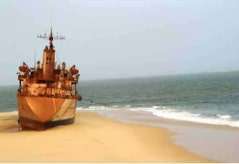August 7th, 2014

Recently, I saw a performance by the Mauritanian singer Noura Mint Seymali, who plays the 9-string harp, the ardin (reserved only for women), and her talented musicians at the Skirball Cultural Center in Los Angeles. The Skirball hosts free summer concerts bringing in international artists and performers to give us Angelenos a taste of the musical flavors from around the world. Noura’s melodic voice and music, a blend of Berber, Afro-pop, and desert blues had everyone on their feet dancing; transporting us to a desert oasis thousands of miles away.
YouTube link: http://www.youtube.com/watch?v=5HLfWoZhC7s
Influenced by its Moorish past, Mauritania has a rich and thriving music culture (as evidenced by the performers I saw at the Skirball).
In terms of geography, Mauritania (three times the size of Arizona) is situated in northwest Africa with about 350 mi (592 km) of coastline on the Atlantic Ocean. In the north, it is bordered by Morocco and on the east by Algeria and Mali, and Senegal on the south. The country is 70% desert and growing because of ongoing droughts, with the exception of the fertile Senegal River valley in the south and grazing land in the north.

Image source: Steve McCurry’s Blog
The history of Mauritania dates back to the 3rd century AD. The original settlers of Mauritania were the Bafours people. Berber tribes began migrating to the region between the 3rd and 7th century AD removing all traces of the Bafours people. The Mauritanian Thirty-Year War occurred between 1644 and 1647 when the Beber fought against the Beni Hassan tribes and Maqil Arab invaders.
Mauritania was first explored by the Portuguese in the 15th century, but by the 19th century the French had gained control and became one of the colonies that constituted French West Africa. In 1946, it was named a French overseas territory.
Now, here are some fast facts on Mauritania:
1. Mauritania gained its independence from France on Nov. 28, 1960, and was admitted to the United Nations in 1961. (Having once been a French colony, Mauritannia’s education system has been heavily influenced by the francophone system which is still prevalent today even after its independence.)
2. The capital of Mauritania is Nouakchott, which means “place of the winds.” It was designated as the country’s capital only in 1960 and is therefore one of the world’s newest capitals.

Nouakchott, capital of Mauritannia
3. Mauritania is one of the last countries to abolish slavery. It passed a law in 1981 to abolish slavery. Yet, according to 2003 estimates, despite the legislation against slavery, there still exists around 90,000 slaves in Mauritania.

Image source: http://borgenproject.org/modern-day-slavery-mauritania/
4. Majority of Mauritanians are devout Moslems and belong to the Sunni sect.
5. Arabic is the official and national language. Other languages spoken include: Pulaar, Soninke, Wolof (all national languages), French, Hassaniya (a variety of Arabic).

6. If you look at Mauritania from space, you can see a clear bull’s-eye-like image called “The Eye of Africa.” It is a Richat structure with a diameter of about 30 miles and believed to be the result of the simultaneous lifting of the underlying geology. It is, nevertheless, quite striking.

7. With about 40% of its population still below the poverty line, Mauritania depends heavily on iron ore exports, fishing and off shore oil wells for its economic progress. In addition to ion ore, Mauritania’s other natural resources include gold, gypsum, phosphate, diamonds, copper and oil.
8. Mauritania’s extensive coastline offers excellent opportunities for those who wish to explore the beach, surf, swim or fish in the sea.

9. France’s colonial influence is apparent in Mauritania’s education system that follows the francophone system. Primary school covers 6 years and begins at age six, followed by 7 years of secondary education which leads to the Secondary Education Diploma “Diplome du Baccalauréat de l’Enseignement du Secondaire” (BAC),
10. Mauritania’s University of Nouakchott offers two-year Diploma programs (“Diplome d’Etudes Universitaires Géneralés” also called “DEUG”) followed by two additional years for the “Maitrise.” There are also seven specialized institutions of higher education
Bonus fact:
11. Mauritania’s Bay of Nouadhibou, hides one of the biggest ships cemeteries in the world. There are more than 300 wrecks from all nations beached permanently on its shores. (For more images of shipwrecks on Mauritania’s shores click here: http://www.fogonazos.es/2006/11/shipwrecks-on-coast-of-mauritania.html)

Sources:
http://www.bbc.com/news/world-africa-13881985
https://www.cia.gov/library/publications/the-world-factbook/geos/mr.html
http://www.wfp.org/countries/mauritania

Jasmin Saidi-Kuehnert
[email protected]
![]()
https://acei-global.org/
